Balls of Hyaloclastite
17.2.2010 | 18:52
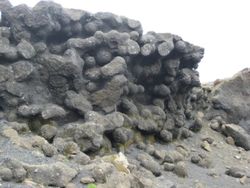 It is a bit peculiar that the name of the largest eruption in Iceland, in fact the largest lava eruption in history, is taken from a mountain that did not erupt. I am referring to the hyaloclastite mountain Laki in southern Iceland. Laki mountain was split in two in the great eruption of 1783 when a 25 km long fissure rifted the terrain and created Eldhraun, the Fire Lava. The rifting produced two prominent faults that flank the fissure, where we can see well the interior of the Laki mountain. The hyalocastite was formed during subglacial eruptions in the last ice age, or more than ten thousand years ago.
It is a bit peculiar that the name of the largest eruption in Iceland, in fact the largest lava eruption in history, is taken from a mountain that did not erupt. I am referring to the hyaloclastite mountain Laki in southern Iceland. Laki mountain was split in two in the great eruption of 1783 when a 25 km long fissure rifted the terrain and created Eldhraun, the Fire Lava. The rifting produced two prominent faults that flank the fissure, where we can see well the interior of the Laki mountain. The hyalocastite was formed during subglacial eruptions in the last ice age, or more than ten thousand years ago. 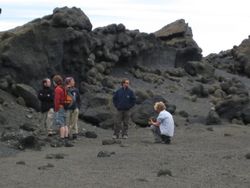 Anyone who enters into the canyon made by the fault line is amazed to see that the hyaloclastite rock is full of spherical structures about the size of a football or a man´s head. Many tourists come here, and Kári Kristjánsson, the ranger of the Lakagígar fisure, is not enthusiastic about how tourists treat these important geological artefacts. Some tourists arrange the balls into piles, like soldiers stacked cannon balls in centuries past, and others use the balls to play bowling games. But he is least impressed when tourists stuff them in their backpacks and attempt to carry the balls off. As you can see from the photograph above, the balls are inside the hyalocalstite formation, but they weather out and are scattered on the ground below. The balls are a bit harder than the hyaloclastite and wether more slowly, but in other respects they are identical to the hyaloclastite, composed of glass particles, volcanic ash and small fragments of basalt, all cemented together into a hard rock.
Anyone who enters into the canyon made by the fault line is amazed to see that the hyaloclastite rock is full of spherical structures about the size of a football or a man´s head. Many tourists come here, and Kári Kristjánsson, the ranger of the Lakagígar fisure, is not enthusiastic about how tourists treat these important geological artefacts. Some tourists arrange the balls into piles, like soldiers stacked cannon balls in centuries past, and others use the balls to play bowling games. But he is least impressed when tourists stuff them in their backpacks and attempt to carry the balls off. As you can see from the photograph above, the balls are inside the hyalocalstite formation, but they weather out and are scattered on the ground below. The balls are a bit harder than the hyaloclastite and wether more slowly, but in other respects they are identical to the hyaloclastite, composed of glass particles, volcanic ash and small fragments of basalt, all cemented together into a hard rock.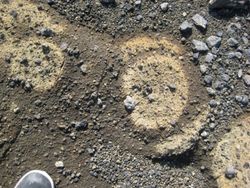 Hyaloclastite, called móberg in Icelandic, is in fact the most amazing rock of Iceland and should be the national rock. It is much more common in Iceland than anywehre else on Earth, and the hyaloclastite mountains are an important feature of the Icelandic landscape. This rock does not get enough respect in Iceland, and it was in fact not until the eruption of the island of Surtsey in 1963 that scientists figured out fully how this rock is formed. We now know that hyaloclastite is hardened volcanic ash or tephra, which has become cemented into rock.
Hyaloclastite, called móberg in Icelandic, is in fact the most amazing rock of Iceland and should be the national rock. It is much more common in Iceland than anywehre else on Earth, and the hyaloclastite mountains are an important feature of the Icelandic landscape. This rock does not get enough respect in Iceland, and it was in fact not until the eruption of the island of Surtsey in 1963 that scientists figured out fully how this rock is formed. We now know that hyaloclastite is hardened volcanic ash or tephra, which has become cemented into rock. 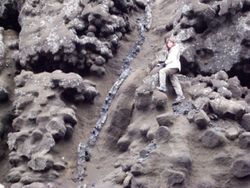 In most cases the volcanic ash has the chemistry of basalt, and is formed when basalic magma comes in contact with water, either below a glacier, in the ocean or in a lake. But how are the mysterious hyaloclastite cannon balls formed?The first to describe them in print was the geologist Jón Jónsson in 1987. He wrote: “The hyaloclastite balls are simply tephra balls, which have formed when wet or suitably moist volcanic ash layer rolled upp.” His idea was that the balls were syndepositional, or formed at the same time that the deposit formed.
In most cases the volcanic ash has the chemistry of basalt, and is formed when basalic magma comes in contact with water, either below a glacier, in the ocean or in a lake. But how are the mysterious hyaloclastite cannon balls formed?The first to describe them in print was the geologist Jón Jónsson in 1987. He wrote: “The hyaloclastite balls are simply tephra balls, which have formed when wet or suitably moist volcanic ash layer rolled upp.” His idea was that the balls were syndepositional, or formed at the same time that the deposit formed. 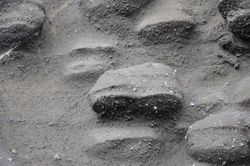 I disagree with that interpretation.The best and largest occurrence of hyaloclastite balls that I have seen occur in the western part of Kerlingarfjall mountain on Snćfellsnes in western Iceland. The hyaloclastite cliffs here are several tens of meters in height, and they are full of balls that are about 30 cm in diameter. The photo above shows the cliff, but in right light conditions, especially at dusk, this is the most ghostly place I have ever visited, when the hundreds of balls stick out of the wall, like the heads of human corpses that have been stacked up and turned to stone.
I disagree with that interpretation.The best and largest occurrence of hyaloclastite balls that I have seen occur in the western part of Kerlingarfjall mountain on Snćfellsnes in western Iceland. The hyaloclastite cliffs here are several tens of meters in height, and they are full of balls that are about 30 cm in diameter. The photo above shows the cliff, but in right light conditions, especially at dusk, this is the most ghostly place I have ever visited, when the hundreds of balls stick out of the wall, like the heads of human corpses that have been stacked up and turned to stone. 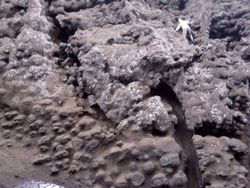 Hyaloclastite balls of all sizes are common in the Kerlingarfjall mountain, and also in Valabjörg to the east.When we look more closely, we can see that there is a faint stratification in the hyaloclastite of Kerlingarfjall, and that the layering cuts right through some of the balls, as the photos show. Layering is of course produced mainly during the eruption and is caused when explosions produce volcanic ash or tephra of varying grain size. But if the stratification cuts across the balls, then the hyaloclastite balls must clearly have formed AFTER the layering, and the balls are herefore a postdepositional feature, formed after the eruption. They are most likely analogous to concretions that form in sedimentary rocks.
Hyaloclastite balls of all sizes are common in the Kerlingarfjall mountain, and also in Valabjörg to the east.When we look more closely, we can see that there is a faint stratification in the hyaloclastite of Kerlingarfjall, and that the layering cuts right through some of the balls, as the photos show. Layering is of course produced mainly during the eruption and is caused when explosions produce volcanic ash or tephra of varying grain size. But if the stratification cuts across the balls, then the hyaloclastite balls must clearly have formed AFTER the layering, and the balls are herefore a postdepositional feature, formed after the eruption. They are most likely analogous to concretions that form in sedimentary rocks. 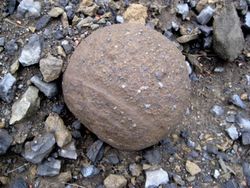 They are created when a process of crystallization begins from a nucleus and then radiates outward to form a spherical structure. Thus it is the cement within the balls that gives them the spherical shape.
They are created when a process of crystallization begins from a nucleus and then radiates outward to form a spherical structure. Thus it is the cement within the balls that gives them the spherical shape.Flokkur: Vísindi og frćđi | Facebook







Bćta viđ athugasemd [Innskráning]
Ekki er lengur hćgt ađ skrifa athugasemdir viđ fćrsluna, ţar sem tímamörk á athugasemdir eru liđin.